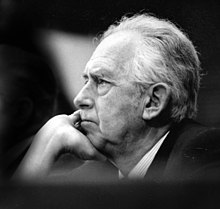János Szentágothai
János Szentágothai (born October 31, 1912 in Budapest ; † September 8, 1994 there ) was a Hungarian anatomist, neurobiologist, politician and president of the Hungarian Academy of Sciences .
Life
Szentágothai was born in 1912 as the second of six sons of the doctor Gustav Schimert and his wife Margit Antal. Szentágothai attended the German primary school in Budapest and graduated from the Reichsdeutsche Schule.
From 1930 Szentágothai studied medicine at the Péter Pázmány University and soon became a research student with the anatomy professor Mihály Lenhossék . In 1936 he successfully completed his studies and stayed at the university. In 1942 he became a research assistant. During the Second World War he served as a doctor. In protest against the German occupation of Hungary, he changed his surname in memory of the place of origin of his paternal ancestors Szentágota von Schimert in Szentágothai. He became a prisoner of war and returned home in 1946. At the medical faculty of the University of Pécs , he became head of the anatomy department. His specialty became neuroendocrinology and neuroanatomy . In 1948 he was elected a corresponding member of the Hungarian Academy of Sciences. In 1961 he founded the department for electron microscopy in brain research.
From 1963 he became a full professor of anatomy at the Medical University of Budapest . His main research areas were the cerebellum and the cerebral cortex . Szentágothai also researched the spinal cord and the reflex mechanisms of the brain stem . In 1964 he was elected a member of the Leopoldina . In 1967 the physician became a full member of the Academy of Sciences, 1972 of the National Academy of Sciences of the United States, 1973 of the American Academy of Arts and Sciences and 1992 of the Académie des Sciences . Until 1977 he headed the anatomy department, in 1986 he retired.
In 1973 Szentágothai became vice-president of the Academy of Sciences. Four years later he became president and was again from 1980 to 1985. In 1977 he gave up the management of anatomy. In 1985 he became a deputy and member of the Presidential Council of the People's Republic of Hungary. In the 1990 elections he became a member of the Democratic Forum and a member of the Foreign Affairs Committee. Szentágothai died a few weeks after the end of the legislature in 1994.
family
The ancestors of the father were Transylvanian Saxons , those of the mother Hungarians . Many of Szentágothai's relatives were doctors, including his grandfather Géza Antal , who had been the first professor of urology in Hungary, and his great-grandfather Sándor Lumnitzer , who was a well-known surgeon in Hungary. On June 7, 1938, Szentágothai married Alice Biberauer. The couple had three daughters: Katalin (1939), Klára (1941) and Mária Krisztina (1951). All three also became medical doctors. Four Szentágothais brothers also studied medicine and later lived in the United States and Germany.
Awards
- 1950: Kossuth Prize
- 1970: Hungarian State Prize
- 1985: Gold Medal of the Hungarian Academy of Sciences
- 1992: Hungarian Order of Merit
- Member of the Royal Society
- Honorary doctorates from the Universities of Oxford, Turku and Pécs
Publications (selection)
One of Szentágothai's most important books is his anatomy atlas, which is considered the standard work in Hungary.
- with John Eccles and Ito Masao: The cerebellum as a neuronal machine. Springer, New York 1967.
- Hypothalamic control of the anterior pituitary: an experimental-morphological study. Akadémiai Kiadó, Budapest 1968.
- with Ferenc Kiss: Atlas of Macroscopic Anatomy for Dentists. Akadémiai Kiadó, Budapest 1969.
- Synaptology of the visual cortex. In: Giovanni Berlucchi et al .: Visual Centers in the Brain. Springer, Berlin / Heidelberg 1973, pp. 269-324.
- with Ferenc Kiss: Anatomical Atlas of the Human Body. 3 volumes. Thieme, Leipzig 1976–1979.
- The modular architectonic principle of neural centers. In: Reviews of Physiology, Biochemistry and Pharmacology. 98: 11-61 (1983).
- Modular organization of nervous central organs, especially the cerebral cortex. Westdeutscher Verlag, Opladen 1989, ISBN 3-531-08372-4 .
- with Michael A. Arbib and Péter Érdi: Neural organization: Structure, function, and dynamics. MIT Press, Cambridge 1998
literature
- Bela Flerkó: John Szentágothai. Budapest: Academic Press, 1998th (The last Hungarian scientists) ISBN 963-05-7490-X
- Bela Fisherman: John Szentágothai (1912–1994), In: Famous Hungarian doctors. Eds. Kapronczay Charles E. Water New Year's Eve. Bp: Galen, 2000, 126-131.
- Balázs Gulyás, Peter Somogyi: János Szentágothai October 31, 1912 - September 8, 1994. In: Biographical Memoirs of Fellows of the Royal Society. Vol. 59 (2013), pp. 383-406, DOI: 10.1098 / rsbm.2012.0038 .
- Nicholas Réthelyi: John Szentágothai. In: Zs to Hungarian scientist from the lexicon. Spices. Ferenc Nagy. Budapest: Better, MTESZ; OMIKK. 1997th 762-764. P. ISBN 963-85433-5-3
- Nicholas Réthelyi: John Szentágothai. In: National anniversary 2012th Editor: John Eston. Bp: Balassi Institute, 2012. 5-8. (PDF format. Anniversary National 2012)
- Hungary Nagy Lexicon XVI. (Sel-Sat). Spices. Lamb Laszlóné. Budapest: Hungarian Grand Lexicon. 2003rd 644 of P. ISBN 963-9257-15-X
- Choice - Parliamentary Almanac 1990, Budapest: Local Propaganda and Publishing Company, 1990, 233 old.
Web links
Individual evidence
- ^ A b Peter Somogyi: Obituary: Professor John Szentagothai , The Independent . 17th September 1994.
- ↑ Member entry of János Szentágothai (with picture) at the German Academy of Natural Scientists Leopoldina , accessed on May 27, 2016.
- ^ List of members since 1666: Letter S. Académie des sciences, accessed on March 6, 2020 (French).
- ↑ Janos Szentagothai, Neurobiologist, 81 , The New York Times . September 15, 1994.
| personal data | |
|---|---|
| SURNAME | Szentágothai, János |
| BRIEF DESCRIPTION | Hungarian anatomist, neurobiologist, university professor, politician and President of the Hungarian Academy of Sciences |
| DATE OF BIRTH | October 31, 1912 |
| PLACE OF BIRTH | Budapest |
| DATE OF DEATH | September 8, 1994 |
| Place of death | Budapest |
